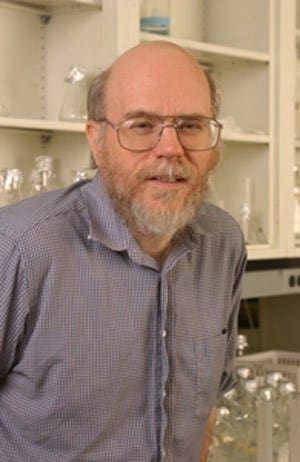
Edward Hedgecock
Professor
Contact Information
- [email protected]
- 007 Biology East
- Lab 410-516-8381
Research Interests: Developmental genetics of the nervous system of Caenorhabditis elegans
Education: PhD, University of California, Santa Cruz
Edward Hedgecock received his PhD from the University of California, Santa Cruz. He went on to complete his postdoctoral work at the MRC Laboratory of Molecular Biology, Cambridge, U.K. as well as the Roche Institute of Molecular Biology.
Developmental Genetics of the Nervous System of Caenorhabditis Elegans
Various cells in animals migrate after their birth to distant sites where they divide or differentiate. Germline and gonadal cells, for example, originate separately but move to a common site to form the reproductive primordia. Growth cones migrate along glial or axonal surfaces to bring remote neurons into contact for synaptic communication. We are using genetics and molecular biology to discover and analyze the spatial cues and navigational programs that guide complex migrations during development.
Each cell or axon migration comprises a series of attachments and detachments of motile cells to stationary cells, or extracellular matrix, which support and guide their movements. Some migrations are simple dispersals away from an origin, but most follow elaborate, stereotyped trajectories that presumably require sequential responsiveness to different extrinsic cues (see Figure). To understand directed migration, we must identify the cues provided by substratum cells and establish their spatial distribution, identify complementary receptors on migrating cells and elucidate navigational programs that activate these receptors in proper sequence, and determine how receptor/ligand binding actually steers the leading edge of a cell or growth cone.
Mutants with abnormal cell or axonal trajectories can identify genes involved in the generation or detection of guidance cues. Because of its cellular simplicity and excellent genetics, the free-living nematode C. elegans has proved useful for mutant analyses of developmental processes, including migrations, that depend on interactions between distinct cell types. Nearly 30 genes affecting cell migrations or axon outgrowth have been discovered to date. Some mig genes affect specific navigational steps while others are strikingly pleiotropic. Two such genes have been sequenced thus far; their deduced products are a basement membrane protein and a trans-membrane receptor, respectively.
Selected publications:
Ikeda DD, Duan Y, Matsuki M, Kunitomo H, Hutter H, Hedgecock EM, Iino Y. (2008). CASY-1, an ortholog of calsyntenins/alcadeins, is essential for learning in Caenorhabditis elegans. Proc Natl Acad Sci U S A. 105(13):5260-5.
Walston T, Guo C, Proenca R, Wu M, Herman M, Hardin J, Hedgecock E. (2006). mig-5/Dsh controls cell fate determination and cell migration in C. elegans. Dev Biol. 298:485-97.
Dong C, Muriel JM, Ramirez S, Hutter H, Hedgecock EM, Breydo L, Baskakov IV, Vogel BE. (2006). Hemicentin assembly in the extracellular matrix is mediated by distinct structural modules. J Biol Chem. 8;281(33):23606-10.
Kao G, Huang CC, Hedgecock EM, Hall DH, Wadsworth WG. (2006). The role of the laminin beta subunit in laminin heterotrimer assembly and basement membrane function and development in C. elegans. Dev Biol. 290(1):211-9.
Hutter H, Wacker I, Schmid C, Hedgecock EM. (2005). Novel genes controlling ventral cord asymmetry and navigation of pioneer axons in C. elegans. Dev Biol. 284(1):260-72.
Yochem J, Hall DH, Bell LR, Hedgecock EM, Herman RK. (2005). Isopentenyl-diphosphate isomerase is essential for viability of Caenorhabditis elegans. Mol Genet Genomics. 273(2):158-66.
Wacker I, Schwarz V, Hedgecock EM, Hutter H. (2003). zag-1, a Zn-finger homeodomain transcription factor controlling neuronal differentiation and axon outgrowth in C. elegans. Development.130(16):3795-805. PMID: 12835395.
Huang CC, Hall DH, Hedgecock EM, Kao G, Karantza V, Vogel BE, Hutter H, Chisholm AD, Yurchenco PD, Wadsworth WG. (2003). Laminin alpha subunits and their role in C. elegans development. Development. ul;130(14):3343-58.
Poinat P, De Arcangelis A, Sookhareea S, Zhu X, Hedgecock EM, Labouesse M, Georges-Labouesse E. (2002). A conserved interaction between beta1 integrin/PAT-3 and Nck-interacting kinase/MIG-15 that mediates commissural axon navigation in C. elegans. Curr Biol. 12(8):622-31.
Bercher M, Wahl J, Vogel BE, Lu C, Hedgecock EM, Hall DH, Plenefisch JD. (2001). mua-3, a gene required for mechanical tissue integrity in Caenorhabditis elegans, encodes a novel transmembrane protein of epithelial attachment complexes. J Cell Biol. 23;154(2):415-26.
Vogel BE, Hedgecock EM. (2001). Hemicentin, a conserved extracellular member of the immunoglobulin superfamily, organizes epithelial and other cell attachments into oriented line-shaped junctions. Development.128(6):883-94.
Kipreos ET, Gohel SP, Hedgecock EM. (2000). The C. elegans F-box/WD-repeat protein LIN-23 functions to limit cell division during development. Development. 127(23):5071-82.